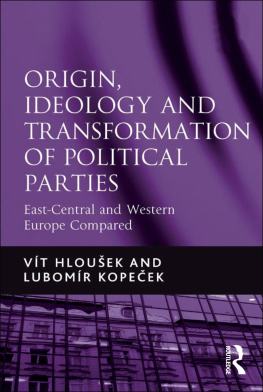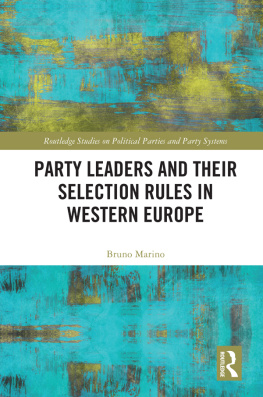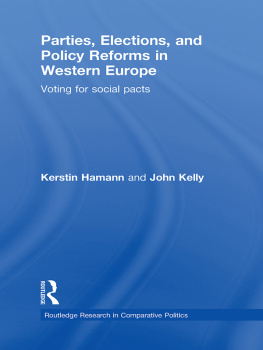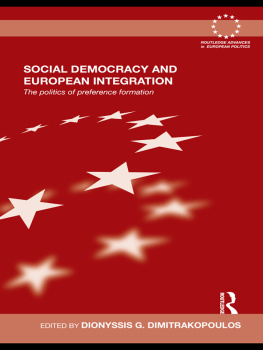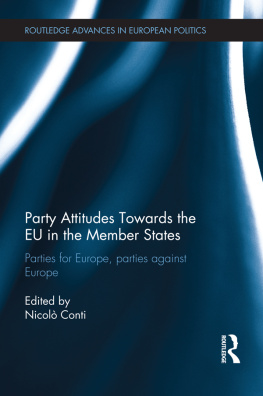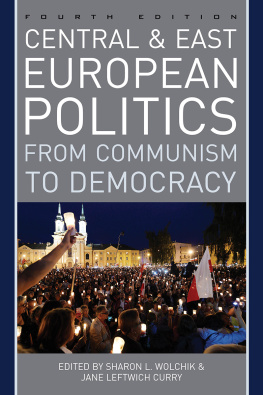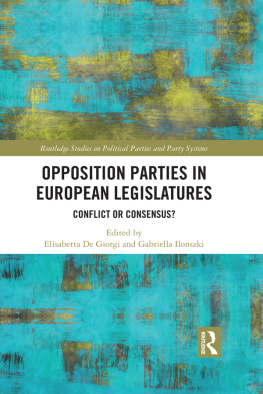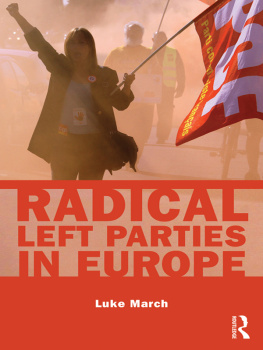ORIGIN, IDEOLOGY AND TRANSFORMATION OF POLITICAL PARTIES
Dedicated to Anastzie, Eva and Klra
Origin, Ideology and Transformation of Political Parties
East-Central and Western Europe Compared
VT HLOUEK
and
LUBOMR KOPEEK
Masaryk University, Czech Republic
First published 2010 by Ashgate Publishing
Published 2016 by Routledge
2 Park Square, Milton Park, Abingdon, Oxon OX14 4RN
711 Third Avenue, New York, NY 10017, USA
Routledge is an imprint of the Taylor & Francis Group, an informa business
Copyright Vt Hlouek and Lubomr Kopeek 2010
Vt Hlouek and Lubomr Kopeek have asserted their right under the Copyright, Designs and Patents Act, 1988, to be identified as the authors of this work.
All rights reserved. No part of this book may be reprinted or reproduced or utilised in any form or by any electronic, mechanical, or other means, now known or hereafter invented, including photocopying and recording, or in any information storage or retrieval system, without permission in writing from the publishers.
Notice:
Product or corporate names may be trademarks or registered trademarks, and are used only for identification and explanation without intent to infringe.
British Library Cataloguing in Publication Data
Hlousek, Vit.
Origin, ideology and transformation of political parties : East-Central and Western Europe compared.
1. Political parties--Europe, Eastern. 2. New democracies--Europe, Eastern. 3. Europe, Eastern--Politics and government--1989- 4. Comparative government.
I. Title II. Kopecek, Lubomir.
324.20943-dc22
Library of Congress Cataloging-in-Publication Data
Hlousek, Vit
Origin, ideology, and transformation of political parties : East-Central and Western Europe compared / by Vit Hlousek and Lubomir Kopecek.
p. cm.
Includes bibliographical references and index.
ISBN 978-0-7546-7840-3 (hardback) -- ISBN 978-1-3155-9910-6 (ebook)
1. Political parties--Europe. 2. Ideology--Europe. 3. Europe--Politics and government-- 1989- 4. Comparative politics. I. Kopecek, Lubomir II. Title.
JN50.H63 2010
324.24--dc22
2010006279
ISBN 9780754678403 (hbk)
ISBN 978-1-3155-9910-6 (ebk-PDF)
ISBN 9781317085027 (ebk-ePUB)
Contents
List of Tables
Preface
The changes in East-Central and Eastern Europe in the late 1980s, early 1990s transformed dictatorship into democracy. A new face of Europe emerged; the Iron Curtain came down and the countries to the east began to reconnect with the western part of the continent. Two decades have now passed since the shift to democracy and during that time the type of politics in the countries of the former east bloc have changed dynamically. The formation and consolidation of the new democracies have become the subject of intense interest. Hundreds of works have been written focusing on various aspects of the post-Communist countries: from the forming of constitutional and political systems to the building of civil society. A number of comparative studies have also appeared all across East-Central and Eastern Europe.
Nevertheless, with the changes over the years in the external context and the various trajectories of individual countries, the comparison of political systems in the post-communist countries has somewhat lost its original urgency. On the one hand, comparison of the old and new democracies has become increasingly more interesting. Today, the West and East European countries share a common political space the European Union (EU). Most significantly, trends similar to those in traditional European democracies had already started to appear even before the East-Central European countries joined the EU. At the same time, however, old political, social, and economic factors were still at work. These included not only the legacy of the communist regimes, but older, pre-Communist history. These trends offer us a fascinating perspective for analysis on the similarities and differences in these trajectories, and a search for their roots.
The publication you have before you attempts to describe the East-Central European parties and their Western European counterparts alongside one another. The framework we use for analysis is the concept of party families; one of the most frequently-used approaches in political science today. Introduced in the first chapter of this book, this concept provides a common introductory framework making possible further and more empirically laden chapters with a comparative look at the individual party groups social democrats and socialists, communists and the far left, greens, agrarians, liberals, Christian democrats, conservatives, the far right, and regional and ethnic parties. At the beginning of the chapters on individual party families an overview is given of their origin, development, significance, ideology, and current status in Western Europe. The central part of each chapter focuses on the shape of the party family in East-Central Europe after 1989, introduced by a brief description of their historical predecessors.
The basic concept of party families we apply was presented in the early 1980s by German scholar Klaus von Beyme. There are at least two main reasons for our selection. First, it is concept widely used in the Western political science and applied by many authors in many Western European countries contexts. Concepts tailored for East-Central or Eastern Europe showed clear discrepancies vis--vis dynamics and instability of the party systems in post-communist world, as discussed in the first chapter. Second, for Western, and especially for Anglo-Saxon community, the EastWest comparison on which this book is based is much more interesting. This implies the inevitable need for scientific tools applicable both to Western and Central-Eastern European reality, which the selected conceptual framework allows. Besides, using this framework is more comprehensible to the scientific community than any attempt to come up with new theoretical approaches.
In view of the diversity of the post-Communist region we have decided to include in the study five relatively similar, adjacent East-Central European countries: the Czech Republic, Hungary, Poland, Slovakia, and Slovenia. The political parties in these counties after 1989 showed a convergence with the West European family models. There is also the important factor of the pre-Communist past. Before the First World War, when political pluralism was born in East-Central Europe, these countries were part of a common state, the Austro-Hungarian Empire, under the rule of the Habsburgs. The Poles were a partial exception as their territory was partitioned between Austria, Russia, and Germany. Their common political framework had major significance for some of the trends influencing the identity of parties in individual countries today. The Habsburg monarchy, despite significant differences in the level of democratization between its more progressive western (Austrian) and Eastern (Hungarian) parts, was generally a more favorable environment for the formation of modern political parties than in more easterly territories of Europe. The inter-war period, despite the territorially and temporally limited existence of the democratic regimes in this area only in Czechoslovakia did democracy survive until 1938 determined the possibilities for shaping the parties, and these factors reassumed their significance in the period after 1989.

